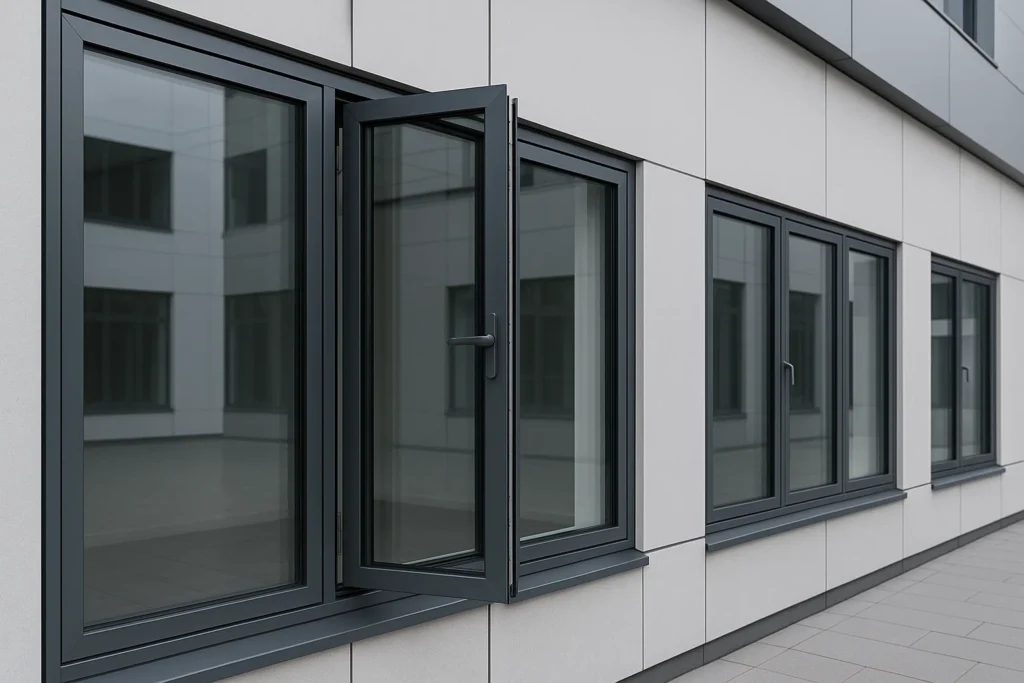
“I finally sleep at night—our street-front showroom is no longer a soft target.”
— Midwest Dealer Network Operations Manager
If you sell windows to professional buyers, security stands shoulder to shoulder with energy ratings and lead times. Yet prospects still ask, “Are Casement Windows really safe?” This guide offers engineering proof, ROI math, and myth-busting arguments that help you price with confidence and grow margins.
Engineering That Turns Security Into a Sales Feature
1 Multi-Point Locking: Hidden Muscle Your Customers Will Love
A modern casement window engages up to five steel hooks with one smooth handle turn. All hardware sits inside the sash, shielded from weather and tampering. Super Window flagship line meets BSI PAS 24:2022—documentation insurers and code officials respect.
2 Compression Seal = Zero Prying Gap
Close the vent and the gasket compresses, withstanding roughly 136 kg of static load before deflecting. No gap means no crowbar leverage—a talking-point that wins over smash-and-grab-worried retail chains.
3 Glazing & Frame Upgrades That Upsell Themselves
- Laminated or toughened glass resists impact and cracks in a spider-web pattern, cutting burglary insurance premiums by up to 11 % within three policy years.
- Security hinges with non-removable pins keep the sash locked even if hinge barrels are attacked.
- Internal glazing beads stop thieves from lifting the pane out from outside.
How Does Security Compare Across Window Types?
- Sliding windows: can be lifted off their tracks.
Double-hung windows: depend on surface bolts that corrode in coastal markets.
Outward-opening units (casement): hardware sits inside; glass breakage is the only realistic attack path—and it’s noisy.
“With correct installation the only realistic breach path is through the glass itself.” — UK Fenestration Security White Paper 2024
Optional Reinforcements for High-Risk Projects
Cam or deadbolt secondary locks · Interior bars or decorative grilles · Integrated glass-break sensors · Child-safety restrictors (< 100 mm opening)
Installation Details That Protect Your Reputation
- Anchor stainless TORX screws into structural framing, not shims.
- Keep reveal tolerance within ±2 mm; misalignment ruins lock engagement.
- Seal with low-modulus silicone and leave weep holes clear.
Case Study: From Break-Ins to Break-Even in Nine Months
A Chicago electronics retailer suffered two break-ins via aging single-hung units. After switching to laminated casement window systems, burglaries dropped to zero. Insurance costs fell 11 %, and the upgrade paid for itself within nine months.
Turning Security Into Margin: Dealer Talking Points
Higher Ticket, Higher Trust. Certified security units command 8–12 % better resale. Bundle laminated glazing plus alarm contacts as a “Security Pack”
Maintenance & Lifecycle Economics
Enclosed hardware resists corrosion; an annual silicone spray keeps gearing smooth. In temperate zones, service life exceeds 20 years—about 30 % longer than sliders.
Conclusion: Safe, Marketable, Profitable
When prospects ask whether Casement Windows are safe, respond with engineering proof, compliance papers, and ROI math. Few window types match their sight-lines, ventilation, and built-in security—while still leaving dealers room to upsell.
Casement Window Security Q&A
Can intruders remove the hinges?
A: Security hinges use non-removable pins; multi-point locks keep the sash captive.
Will laminated glass make units too heavy?
A: Adds roughly 1.5 lb/ft²—still within stay capacity.
Does a bigger sash mean weaker security?
A: With steel reinforcement, vents up to 2 m pass EN 1628 impact tests.
How long does installation training take?
A: Half-day workshops certify crews.
What lock maintenance is required?
A: Annual silicone spray; five-year hardware warranty.
For more answers, visit: https://supwindow.com/casement-window-frequently-asked-questions/

